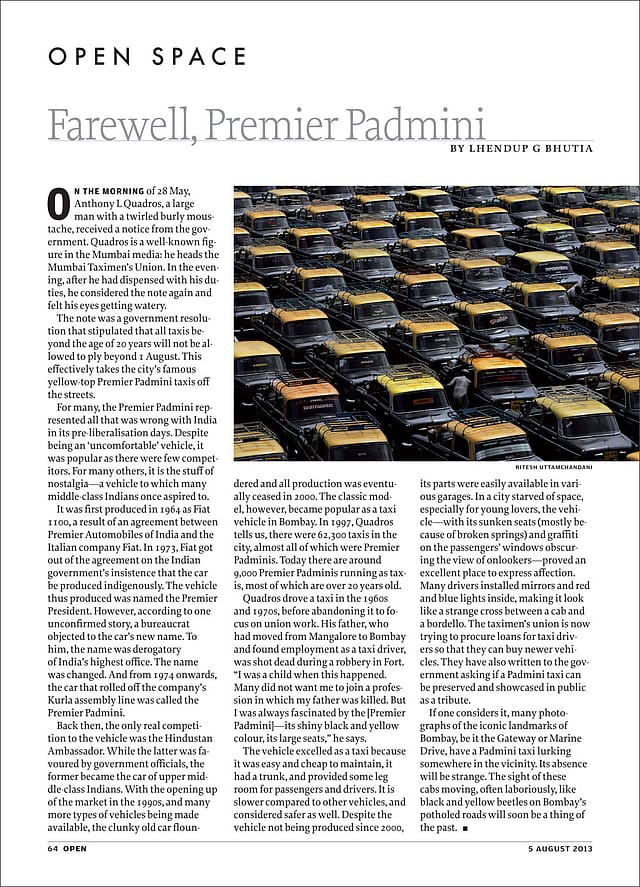Farewell, Premier Padmini

On the morning of 28 May, Anthony L Quadros, a large man with a twirled burly moustache, received a notice from the government. Quadros is a well-known figure in the Mumbai media: he heads the Mumbai Taximen’s Union. In the evening, after he had dispensed with his duties, he considered the note again and felt his eyes getting watery.
The note was a government resolution that stipulated that all taxis beyond the age of 20 years will not be allowed to ply beyond 1 August. This effectively takes the city’s famous yellow-top Premier Padmini taxis off the streets.
On the morning of 28 May, Anthony L Quadros, a large man with a twirled burly moustache, received a notice from the government. Quadros is a well-known figure in the Mumbai media: he heads the Mumbai Taximen’s Union. In the evening, after he had dispensed with his duties, he considered the note again and felt his eyes getting watery.
The note was a government resolution that stipulated that all taxis beyond the age of 20 years will not be allowed to ply beyond 1 August. This effectively takes the city’s famous yellow-top Premier Padmini taxis off the streets.
For many, the Premier Padmini represented all that was wrong with India in its pre-liberalisation days. Despite being an ‘uncomfortable’ vehicle, it was popular as there were few competitors. For many others, it is the stuff of nostalgia—a vehicle to which many middle-class Indians once aspired to.
It was first produced in 1964 as Fiat 1100, a result of an agreement between Premier Automobiles of India and the Italian company Fiat. In 1973, Fiat got out of the agreement on the Indian government’s insistence that the car be produced indigenously. The vehicle thus produced was named the Premier President. However, according to one unconfirmed story, a bureaucrat objected to the car’s new name. To him, the name was derogatory of India’s highest office. The name was changed. And from 1974 onwards, the car that rolled off the company’s Kurla assembly line was called the Premier Padmini.
Back then, the only real competition to the vehicle was the Hindustan Ambassador. While the latter was favoured by government officials, the former became the car of upper middle-class Indians. With the opening up of the market in the 1990s, and many more types of vehicles being made available, the clunky old car floundered and all production was eventually ceased in 2000. The classic model, however, became popular as a taxi vehicle in Bombay. In 1997, Quadros tells us, there were 62,300 taxis in the city, almost all of which were Premier Padminis. Today there are around 9,000 Premier Padminis running as taxis, most of which are over 20 years old.
Quadros drove a taxi in the 1960s and 1970s, before abandoning it to focus on union work. His father, who had moved from Mangalore to Bombay and found employment as a taxi driver, was shot dead during a robbery in Fort. “I was a child when this happened. Many did not want me to join a profession in which my father was killed. But I was always fascinated by the [Premier Padmini]—its shiny black and yellow colour, its large seats,” he says.
The vehicle excelled as a taxi because it was easy and cheap to maintain, it had a trunk, and provided some leg room for passengers and drivers. It is slower compared to other vehicles, and considered safer as well. Despite the vehicle not being produced since 2000, its parts were easily available in various garages. In a city starved of space, especially for young lovers, the vehicle—with its sunken seats (mostly because of broken springs) and graffiti on the passengers’ windows obscuring the view of onlookers—proved an excellent place to express affection. Many drivers installed mirrors and red and blue lights inside, making it look like a strange cross between a cab and a bordello. The taximen’s union is now trying to procure loans for taxi drivers so that they can buy newer vehicles. They have also written to the government asking if a Padmini taxi can be preserved and showcased in public as a tribute.
If one considers it, many photographs of the iconic landmarks of Bombay, be it the Gateway or Marine Drive, have a Padmini taxi lurking somewhere in the vicinity. Its absence will be strange. The sight of these cabs moving, often laboriously, like black and yellow beetles on Bombay’s potholed roads will soon be a thing of the past.
